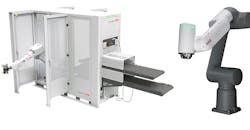Innovations for Industrial and Collaborative Robotics
ABB will present numerous recent developments in its portfolio of robots, software, digital, and educational products at IMTS 2022 – booth 236520 – helping manufacturers of all types address issues in trade and supply-chain complications as well as labor shortages, along with automation and robotics to achieve greater flexibility and relocate production closer to home.
“ABB has continually developed cutting-edge products and support programs to help a wide variety of manufacturers and their employees become more productive, resilient and adaptable. Our IMTS exhibit will showcase a number of these innovations, many of which have opened up robotic automation to a broad group of first time users,” stated Joe Chudy, ABB Robotics‘ US general manager.
Highlights of ABB’s IMTS exhibit include a vision-guided, FlexLoader™ machine tool tending cell; GoFa™ collaborative robot equipped for welding; a live 3D printing demo featuring ABB’s 3D Printing PowerPac for ABB’s RobotStudio® simulation and offline programming software; the MiniMAC robotic grinding cell from ABB Value Provider MESH Automation; and the Cobot FlexTrainer education cell for interactive classroom training.
The FlexLoader machine tool tending cell (shown above, at left) is described by the developer as its “next generation of compact, standardized machine tool tending cells,” and includes a 6-axis robot that meets the reach and payload requirements of specific machine-tending needs. FlexLoaders are suitable for low- or high-volume production, tending vertical lathes, horizontal and vertical machining centers, five-axis machines and grinders.
The user-friendly FlexLoader Vision control technology provides flexible automation for machine tending for small-to-very large parts, increasing machine tool utilization by as much as 60 percent while reducing operating costs, according to ABB.
A GoFa collaborative robot (shown above, at right) welding cell is designed to safely work directly and continuously alongside humans, and to be easy to install and use, GoFa helps businesses automate processes involving heavier loads and longer reaches to assist workers with repetitive and ergonomically challenging tasks.
An additive manufacturing cell with the 3D Printing PowerPac will present a live 3D printing demo featuring an ABB IRB 4400 robot equipped with a MDPH2 end-of-arm-tool, a direct pellet-to-print large-format extruder. The demo will be powered by the recently introduced 3D Printing PowerPac for ABB’s RobotStudio simulation and offline programming software, which eliminates manual programming by translating any standard slicer software design into ABB’s simulation environment and robot code. An operator can progress from the CAD design stage to final modeling of a product in just half an hour.
The MiniMAC Grind robotic deburring cell from MESH Automation, an ABB Robotics system integrator, will be displaying a version of its MiniMAC Grind deburring featuring an ABB IRB 2600 robot and a multi-tool end-of-arm tooling mounted to the robot, which eliminates the need for tool changes. The “pre-machining” system automatically removes excess material from recently cast metal parts.
At the IMTS Smartforce Student Summit pavilion – booth 215110 – ABB’s cobot FlexTrainer education cell will be demonstrated. It’s designed for interactive classroom training using the latest ABB programming technology with any of ABB’s collaborative robots; the demo will feature the new, six-axis GoFa™ collaborative robot. With the Cobot FlexTrainer education cell students can easily program ABB cobots via Lead-Through programming and ABB’s new Wizard easy programming software.
The trainig cell is fenceless, allowing greater interaction between the students and the robot. It features all of the capabilities of ABB’s collaborative robots, including the industry’s most versatile and powerful controller, an ABB FlexPendant, and access to RobotStudio®, ABB’s offline programming software.
Get more info at www.abb.com/robotics